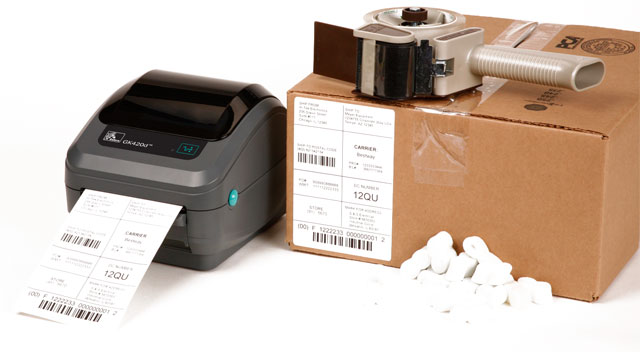Tech Tip Tuesday: What Do I Need To Print Out My Barcodes?
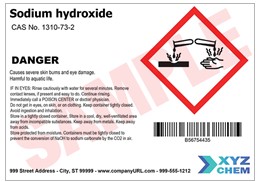 Following up on the last tech tip Tuesday, now that you have figured out how to get your own barcodes it is time to print them out. So what do you need to print out the barcodes?
Following up on the last tech tip Tuesday, now that you have figured out how to get your own barcodes it is time to print them out. So what do you need to print out the barcodes?
Barcodes.
First, you have to design and create the barcodes in a barcode software. A few that we suggest is Bartender by Seagull Scientific, Nice Label, or Teklynx. These software allow you to design your label and barcodes to hold the info that you need.
The next thing you have to do is to choose a printer that suitable for your need. Below are the printer size we recommend, depending on how many labels you print out in a day and what size do you want your labels to be.
Printers.
Direct Thermal– chemically treated label is heated directly (short-term life on label) Usually used on shipping packages.
Thermal Transfer– ribbon ink is transferred onto the label (will stay on longer on label) Usually used on warehouse/retail store racks.
Desktop Printer– This type of printer, like the GX420t, is made for small volume applications. Usage is suitable for about 300-500 labels per week. It is perfect for asset labeling in an office or light printing duties at a retail store.
Industrial Printer– It is larger and more rugged than desktop models for high volume print applications, like the Datamax I-4212e. Usage is suitable for printing thousands of labels per day. It is great for manufacturing and distribution centers as well as large retailers.
Mobile Printer– This type of printer provides mobility to users, like the Zebra QLn320. It’s small existence allows users to print on the go and perfect for delivery drivers and field workers to create label or receipt.
If you have any questions about what kind of software and printer that you should use, feel free to contact our dedicated account managers and they will be able to provide you with the best solution for your application.
Advantages of PCL-Enabled Thermal Barcode Printers in Distribution & Transportation: Cutting out the Middleware
 Introduction
Introduction
PCL easily integrates to existing software, therefore, the cost of maintenance is lower and eliminates the need for middleware. This white paper to explores the advantages of PCL-enabled thermal barcode printers.
Starting with the basics, barcode technology has a heavy impact on the distribution and transportation industry. The barcode industry benefits not only employees who handle over thousands of packages every day, but customers, who ship those packages. The use of barcodes in these two industries allows daily supply chain activities to be streamlined, therefore, reducing complexity and simplifying the communication between channels. An added benefit of using barcode printers for these activities is the security of using Printer Control Language.
Changing the Printhead and Platen Roller on Your E-Class Printer
Unfortunately, no barcode printer lasts forever but with the right care and maintenance you can get the most out of your investment.
Two of the most common elements of a printer that will wear down and need to be replaced are the printhead and the platen roller. The printhead is the main component of the printer that does the actual printing. It is composed of a series of small ceramic dots that heat up in the pattern of what you want to print. With constant use, printheads do go bad and you can tell by faded printing or, when dots burn out, sections that will not print at all. The platen roller is the main mechanism that pulls the label through the printer as it is being printed. Being a moving part it gets constant use and will eventually wear down providing less pressure on the printhead resulting in printing issues and errors.
Luckily, when these parts go bad it does not mean we need to get a new printer. With all Datamax-O’Neil printers, including their popular E-Class Mark III series, it only takes a few minutes to remove and replace printhead and platen roller to bring a new lease of life to your printer. This video is a great step-by-step illustration of how easy it really is.
Datamax Offers Up To $150 Trade-In Value Towards A New I-Class Mark II

It’s time to make your older label printer make money for you! Trade in your older printer and replace it with a new I-Class Mark II printer for up to a $150 savings.
A brand new I-Class Mark II printer will save you a ton of money! Not only will you earn up to $150 per printer when you trade-in yours old qualifying printer, but your printing operations will quickly become more productive and efficient. This will translate into huge savings of time and money.
Just follow these 3 simple steps:
- Confirm you have a qualifying printer and fill out this form – Trade-In Details
- Purchase a new I-4212E, I-4310e, or I-4606e from January to the end of March 2013 from an authorized Datamax dealer like Barcodes Inc.
- Submit a photo of the serial number tag removed from the trade-in printer.
For more details or help finding the right Datamax printer, contact us at Barcodes Inc.
Datamax-O’Neil Introduces the NETira Software Suite of Printer Tools
Unlock the power of your printers with the NETira suite of software tools designed to expand and enhance the performance of your Datamax-O’Neil printers. NETira offers users the ability to set-up your printer, design custom labels or manage an entire network of printers with the touch of a few buttons. NETira reduces setup time and provides the tools to effectively utilize all of your printer’s capabilities.
Thoroughly tested and certified by Datamax-O’Neil technicians, NETira provides users with easy-to-use software that presents a consistent look and feel for navigation. Whether it’s a single printer or part of a networked environment, NETira applications reduce setup time and provide users with the tools to effectively utilize all of their printers’ capabilities. The NETira suite includes:
Understanding the Value of Genuine Printer Supplies
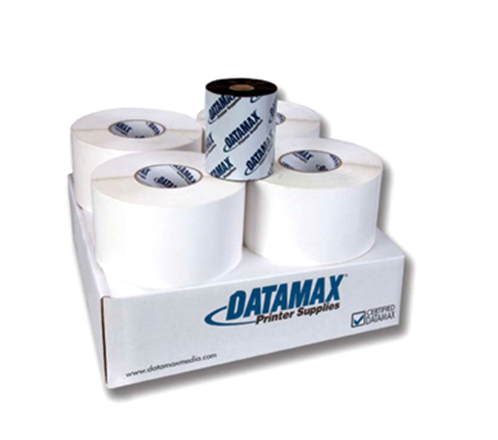 Before purchasing supplies, buyers would do well to remember the words of Warren Buffett, a man who knows a little about buying smartly: “price is what you pay. Value is what you get.” The point is simple: it’s not the initial purchase price that ultimately matters, but rather the value delivered by the purchase. This is particularly true when it comes to printer supplies.
Before purchasing supplies, buyers would do well to remember the words of Warren Buffett, a man who knows a little about buying smartly: “price is what you pay. Value is what you get.” The point is simple: it’s not the initial purchase price that ultimately matters, but rather the value delivered by the purchase. This is particularly true when it comes to printer supplies.
Genuine printer supplies are designed by OEM engineers and qualified with the printer itself as part of the research and product development process. They are developed to precise specifications, so that they perform with the printer at a consistently high level, time and time again.
Only genuine supplies:
- Are engineered in conjunction with the printer for superior quality, performance, and reliability.
- Fully protect your hardware investment.
- Keep warranties beyond reproach.
- Benefit from an OEM’s years of operational experience in the market, and with specific applications.
- Mitigate risk of downtime due to printer failure.
Genuine supplies typically bear the imprint or endorsement of the OEM clearly on the packaging. Consulting the OEM or a recognized OEM channel partner is a sure way of verifying whether the supply you have in hand is genuine.
Continue reading »
E-Class Pro+ Bridges The Gap Between Desktop And Industrial
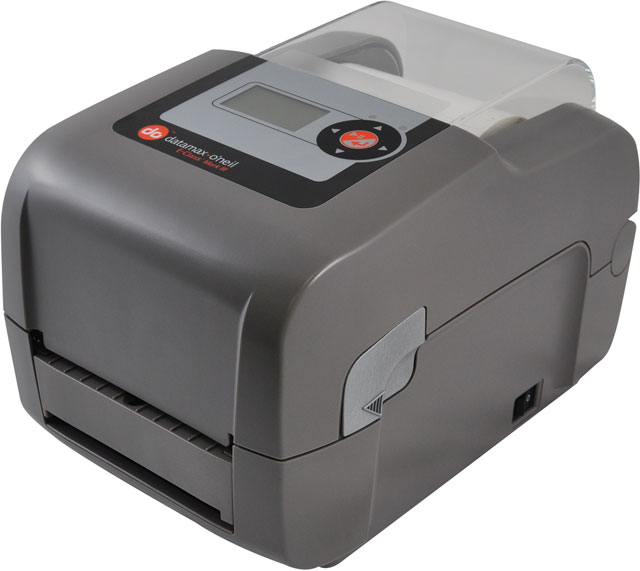
The latest E-Class Mark III printer offers features typically found in industrial printers but at a desktop printer size and price
Datamax-O’Neil announced the availability of its newest E-Class Mark III printer model, the Professional Plus (Pro+). The Pro+ offers a locking media cabinet and enough internal media capacity to hold a 7.2-inch roll of media or stack of fan-folded media — the ideal printer when applications require secure printing or continuous uninterrupted printing. Similar to the Professional model, the Pro+ also offers a fast print speed, expanded communications, real time clock, audible alerts and large display – features normally found in industrial class printers, but available with the E-Class Pro and Pro+ at a desktop printer price.
The Common Sense Case: Why Thermal Trumps Laser for Label Printing
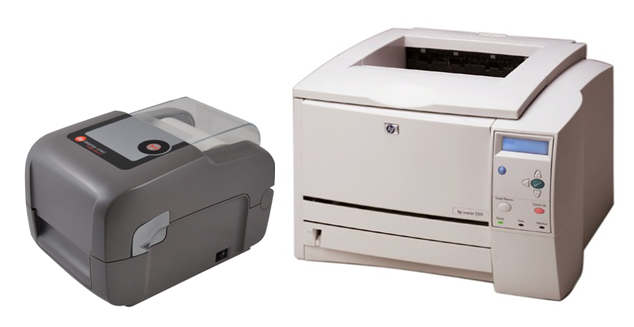
“When you’re finished changing, you’re finished,” said Benjamin Franklin, a printer and purveyor of common sense. This paper, makes the common-sense case for using thermal printers in label applications. In fact, the advantages of thermal over laser are so compelling that the only reason to continue using laser printers for labeling must be habit. Before enumerating the advantages of thermal printing technology over laser, it will be useful to consider the use of laser printers for labeling.
Laser Printing Labeling: History and Concerns
Laser printers have long been used in label printing applications, chiefly because a base of laser printers are usually already installed—primarily for forms, letters, and other narrative communications and documentation. Their multi-function capability made it relatively easy to adopt the laser printer hardware for printing labels. Since adoption was easy, a thorough examination of the technology’s appropriateness was rarely undertaken. Parameters such as operating costs, total cost of ownership, materials and energy usage, ergonomics, and other relevant factors were simply not considered in the label printing context.
After laser label printing applications became the de facto standard, users began to see the shortcomings of using laser printers for this function. While many are now demanding better label printing solutions, they are challenged by inertia in the form of a huge installed base of laser printers.
The Power of Mobile Printing in the Warehouse and Beyond
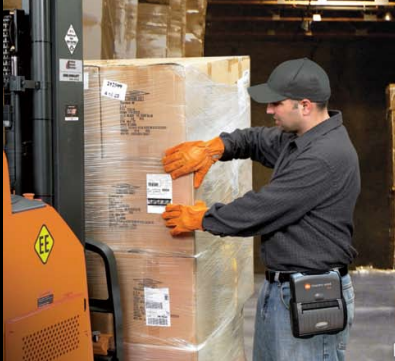 In today’s precarious economic environment, global enterprises are experiencing a dual pinch: one, difficult times have cut operating budgets significantly, and rehiring to support growth after the contraction remains difficult; secondly, as investments in new equipment and systems have been delayed or denied, the optimization of warehouse and supply chain processes has become a critical factor in balancing costs, labor, and assets. What’s more, this optimization must occur while maximizing productivity and improving responsiveness to customer demands.
In today’s precarious economic environment, global enterprises are experiencing a dual pinch: one, difficult times have cut operating budgets significantly, and rehiring to support growth after the contraction remains difficult; secondly, as investments in new equipment and systems have been delayed or denied, the optimization of warehouse and supply chain processes has become a critical factor in balancing costs, labor, and assets. What’s more, this optimization must occur while maximizing productivity and improving responsiveness to customer demands.
With the growing emphasis on cost cutting, companies need to find new and better ways to enhance efficiencies and ensure accuracy across their supply chains and distribution networks. One strategy that is still effective in helping achieve this goal is the implementation of greater mobility into warehousing and distribution functions through devices such as mobile printers.
According to a recent study, mobile devices and software commonly improve workforce production by 20 percent or more. This translates into lower labor costs, lower operating costs, and faster payback on investment. Such gains are not hard to envision. By minimizing the time needed to print labels and apply them to materials, work in process, finished goods, pallets, boxes, and so forth, mobile printers help drive down labor costs while improving performance on the warehouse and DC floors.
Now Shipping the E-Class Professional Series Label Printer
 Datamax-O’Neil Begins Shipping the E-Class Mark III Professional Series Printers
Datamax-O’Neil Begins Shipping the E-Class Mark III Professional Series Printers
The newest E-Class Mark III model offers higher level of functionality at an affordable price
Datamax-O’Neil, a global provider of industrial grade label and receipt printing solutions, announces that it has begun shipping the E-Class Mark III Professional Series printers and that the product is in-stock at major distribution partners. The E-Class Mark III Professional offers the highest level of functionality at an affordable price, and is ideal for businesses with sophisticated applications and more complex printing requirements.



